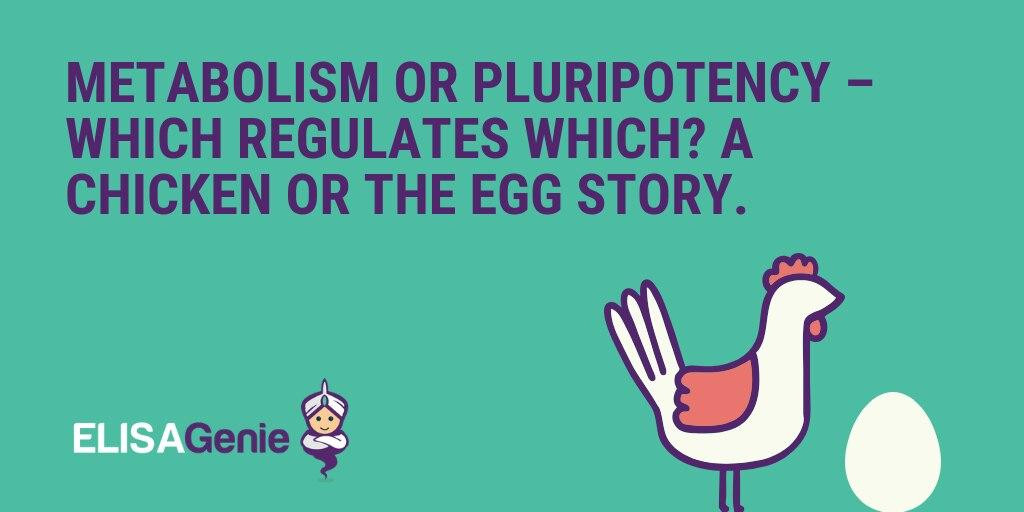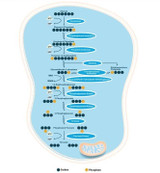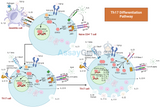Metabolism or pluripotency – which regulates which? A chicken or the egg story.
By Sophie Arthur
How many diseases and conditions do you think exist in this world? Thousands? Hundreds of thousands? Maybe even millions? Unfortunately, I don’t know the answer. But what I do know is there could be one solution to all of them! Yes, one perfect medicine of the future! The answer? Stem cells!
Stem cells, promises & superheroes
Our bodies are made up of an extraordinary amount of cells – all with their own unique shape, function and gene expression, and one of the reasons there are so many diseases we need to know how to treat! But where did all these trillions of cells in our body come from? Well, we all had the same humble beginnings when we were all just a teeny tiny cell: the fertilised egg! This is the ultimate stem cell! It can make all the cells found within your body plus the tissues that make up the placenta which support you as you develop [1]. But during that time, the egg divides and divides into a bunch of other cells until it reaches the blastocyst stage. At this point in development, the embryo is a hollow sphere, except for a bunch of cells clumped together within. This is called the inner cell mass. It is the bunch of cells that made our faces, our limbs and our organs, and they are pluripotent stem cells [2] – our perfect medicine!
Pluripotent stem cells possess two key properties; the ability to self-renew indefinitely and the capability to differentiate into every cell type found within the body [2, 3]. So, it is because of these superpowers that they hold huge hope and promise for being a potential cell source for regenerative medicine. But in order to this we have to be able to maintain a pure and highly pluripotent population of stem cells in the lab, so whenever they are needed to create some neurons to treat an Alzheimer’s patient, or when we need to make some skin cells to treat burns patients, we can! However, at the moment, these differentiation processes in the lab are not as efficient as they are when we are a developing embryo, and one reason for this is because our starting stem cell source is suboptimal, so the best conditions for growing pluripotent stem cells need to be determined.
So, what’s the end goal? If you’re like me and are a fan of superhero movies, you have probably seen that Wolverine and Deadpool have these incredible healing powers. So incredible that if they lose a hand, they can grow a completely new one in a matter of days – and that’s probably down to them having super potent stem cells. Now while stem cell research is nowhere near this stage, there is no reason why we this science fiction can’t become a reality and help us to heal more quickly from stroke damage or rapidly recover from spinal injury [4], for example! But what’s the key to unlocking that highly pluripotent and pure population of stem cells? Well, perhaps it’s their metabolism.
Sugar! Yes please!
Much like, we metabolise our food to get all the nutrients and energy that we need, stem cells need to metabolise something to get their energy so they can grow and divide infinitely! And what is it they metabolise for energy? Glucose! Lots and lots of glucose!
While every cell will metabolise glucose into pyruvate through a process called glycolysis, most cells will then pass the pyruvate on to the mitochondria – the organelles that keep your cells running every day – to break it down further and generate even more energy in the form of ATP [5]. But this is where pluripotent stem cells come unstuck! Their mitochondria are in an immature state so they can only get the majority of their ATP through glycolysis [6]. It’s not until the stem cells lose their pluripotent state and differentiate that they gain fully functional mitochondria either [7]! But interestingly, with the breakthrough of induced pluripotent stem cells, it also revealed an interesting metabolic phenotype. Induced pluripotent stem cells start life as a differentiated cell type with mature mitochondria so get most of their energy through an oxidative phosphorylation based metabolism. But, what is fascinating is that when these cells regain a pluripotent state, there is also a metabolic switch where they now rely on a more glycolytic based metabolism [8], despite having functional mitochondria – which are a much more efficient way of getting energy too [5]! So, there must be some link between glycolysis and maintaining a pluripotent state in stem cells [9]!
So, this begs the question: is it pluripotency that is causing stem cells to rely on glycolysis, or is it that glycolytic metabolism of the stem cells help the stem cells become pluripotent? One of the question I am hoping to answer in my PhD research. A question that might help us to determine those optimal conditions for a highly pluripotent and pure source of stem cells for regenerative medicine.
Metabolism or pluripotency – which came first?
With every different cell phenotype, there are a different set of genes that are expressed. Whether that’s because they are a neuron or a skin cell, whether they need to contract quickly or not, or even whether they have a glycolytic based metabolism or whether they have an oxidative based metabolism. The genes that are expressed are different.
Pluripotent stem cells express three key genes; OCT4, SOX2 and NANOG [10]. My aim is to see whether any glycolytic enzymes or associated proteins change whether these genes are expressed. If a pluripotent stem cell loses the expression of these pluripotency factors, then they will start to differentiate and lose their stem cell status! While there are lots of correlations between increased expressions of glycolytic enzymes leading to an increase in pluripotency [11]– the real question we want to know is how those changes in metabolism are changing gene expression and decipher that interplay between metabolism and epigenetics. One potential solution? Metabolic sensors [12]. So, as well as producing ATP, glycolysis also generates other metabolic by-products, such as NADH for example [5]. There are families of metabolic sensors that require NADH binding in order for them to become active and translocate to the nucleus of cells to change the gene expression. And when stem cells shift towards using glycolysis there is going to be an increase in the amount of NADH and so an increase in the amount of active metabolic sensors. So, while this is a small piece of a much bigger question – my research is looking at whether the glycolytic metabolism associated with pluripotency changed gene expression via these metabolic sensors.
But at the moment, stem cell biologists are still trying to piece together this jigsaw puzzle to get the bigger picture. But if I had to stick my money where my mouth is, what is the answer to that big question; metabolism or pluripotency – which came first?
I’d probably say it’s metabolism!
References
Mitalipov, S. and D. Wolf, Totipotency, pluripotency and nuclear reprogramming. Adv Biochem Eng Biotechnol, 2009. 114: p. 185-99.
Thomson, J.A., et al., Embryonic stem cell lines derived from human blastocysts. Science, 1998. 282(5391): p. 1145-7.
Reubinoff, B.E., et al., Embryonic stem cell lines from human blastocysts: somatic differentiation in vitro. Nat Biotechnol, 2000. 18(4): p. 399-404.
Keirstead, H.S., et al., Human embryonic stem cell-derived oligodendrocyte progenitor cell transplants remyelinate and restore locomotion after spinal cord injury. J Neurosci, 2005. 25(19): p. 4694-705.
Lehninger, A.L., D.L. Nelson, and M.M. Cox, Principles of Biochemistry. 1993, New York, NY: Worth Publishers.
Sathananthan, H., M. Pera, and A. Trounson, The fine structure of human embryonic stem cells. Reprod Biomed Online, 2002. 4(1): p. 56-61.
Cho, Y.M., et al., Dynamic changes in mitochondrial biogenesis and antioxidant enzymes during the spontaneous differentiation of human embryonic stem cells. Biochem Biophys Res Commun, 2006. 348(4): p. 1472-8.
Prigione, A. and J. Adjaye, Modulation of mitochondrial biogenesis and bioenergetic metabolism upon in vitro and in vivo differentiation of human ES and iPS cells. Int J Dev Biol, 2010. 54(11-12): p. 1729-41.
Folmes, C.D. and A. Terzic, Energy metabolism in the acquisition and maintenance of stemness. Semin Cell Dev Biol, 2016. 52: p. 68-75.
Boyer, L.A., et al., Core transcriptional regulatory circuitry in human embryonic stem cells. Cell, 2005. 122(6): p. 947-56.
Christensen, D.R., P.C. Calder, and F.D. Houghton, GLUT3 and PKM2 regulate OCT4 expression and support hypoxic culture of human embryonic stem cells. Scientific Reports, 2015. 5.
Etchegaray, J.P. and R. Mostoslavsky, Interplay between Metabolism and Epigenetics: A Nuclear Adaptation to Environmental Changes. Mol Cell, 2016. 62(5): p. 695-711.
Recent Posts
-
Biological Role of GLP-1
Glucagon-like peptide-1 (GLP-1) is a critical hormone in the regulation of glucose met …20th Jun 2024 -
Th17 Cell Differentiation: Insights into Immunological Dynamics
Th17 cells, a subset of T helper cells characterized by their production of interleukin-17 (IL- …25th May 2024 -
Assay Genie New Asian Distributor May 2024
Dublin, Ireland — May 20th 2024 — Assay Genie, a leading supplier of ELISA Kits, Ant …19th May 2024




